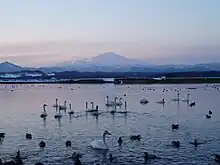Mamurogawa
真室川町 | |
|---|---|
 Mamurogawa Town Hall | |
 Flag  Seal | |
Location of Mamurogawa in Yamagata Prefecture | |
 | |
 Mamurogawa | |
| Coordinates: 38°51′28.4″N 140°15′8.3″E / 38.857889°N 140.252306°E | |
| Country | Japan |
| Region | Tōhoku |
| Prefecture | Yamagata |
| District | Mogami |
| Area | |
| • Total | 374.22 km2 (144.49 sq mi) |
| Population (March 31, 2023) | |
| • Total | 6,792 |
| • Density | 18/km2 (47/sq mi) |
| Time zone | UTC+9 (Japan Standard Time) |
| Phone number | 0233-62-2111 |
| Address | 127-7 Shincho, Mamurogawa-machi, Mogami-gun, Yamagata-ken 999-5301 |
| Climate | Cfa/Dfa |
| Website | Official website |
| Symbols | |
| Flower | Prunus mume |
| Tree | Prunus mume |

Mamurogawa (真室川町, Mamurogawa-machi) is a town located in Yamagata Prefecture, Japan. As of 31 March 2023, the town has an estimated population of 6,792 in 2560 households,[1] and a population density of 18 persons per km². The total area of the town is 374.22 square kilometres (144 sq mi).
Geography
Mamurogawa is located in the northern portion of the Shinjō Basin in north-central Yamagata Prefecture. The basin is surrounded on all sides by low mountains, with the Ōu Mountains to the northeast and the Dewa Mountains running from the west to the north. The area is known for its heavy snowfalls in winter.
Neighboring municipalities
Yamagata Prefecture
Akita Prefecture
Climate
Mamurogawa has a humid continental climate (Köppen climate classification Cfa) with large seasonal temperature differences, with warm to hot (and often humid) summers and cold (sometimes severely cold) winters. Precipitation is significant throughout the year, but is heaviest from August to October. The average annual temperature in Mamurogawa is 10.2 °C (50.4 °F). The average annual rainfall is 2,810.9 mm (110.67 in) with July as the wettest month. The temperatures are highest on average in August, at around 23.2 °C (73.8 °F), and lowest in January, at around −1.0 °C (30.2 °F).[2]
| Climate data for Mamurogawa (1991-2020 normals, extremes 1976-present) | |||||||||||||
|---|---|---|---|---|---|---|---|---|---|---|---|---|---|
| Month | Jan | Feb | Mar | Apr | May | Jun | Jul | Aug | Sep | Oct | Nov | Dec | Year |
| Record high °C (°F) | 12.4 (54.3) |
13.8 (56.8) |
18.5 (65.3) |
29.2 (84.6) |
32.6 (90.7) |
32.2 (90.0) |
35.9 (96.6) |
36.1 (97.0) |
34.2 (93.6) |
28.1 (82.6) |
21.2 (70.2) |
18.2 (64.8) |
36.1 (97.0) |
| Mean daily maximum °C (°F) | 1.9 (35.4) |
2.9 (37.2) |
6.4 (43.5) |
13.4 (56.1) |
20.1 (68.2) |
23.9 (75.0) |
27.0 (80.6) |
28.6 (83.5) |
24.3 (75.7) |
17.8 (64.0) |
10.7 (51.3) |
4.2 (39.6) |
15.1 (59.2) |
| Daily mean °C (°F) | −1.0 (30.2) |
−0.7 (30.7) |
1.6 (34.9) |
7.0 (44.6) |
13.8 (56.8) |
18.4 (65.1) |
22.2 (72.0) |
23.2 (73.8) |
18.9 (66.0) |
12.2 (54.0) |
6.0 (42.8) |
1.1 (34.0) |
10.2 (50.4) |
| Mean daily minimum °C (°F) | −3.9 (25.0) |
−4.1 (24.6) |
−2.3 (27.9) |
1.5 (34.7) |
8.1 (46.6) |
13.5 (56.3) |
18.3 (64.9) |
19.1 (66.4) |
14.8 (58.6) |
7.9 (46.2) |
2.3 (36.1) |
−1.5 (29.3) |
6.1 (43.1) |
| Record low °C (°F) | −14.6 (5.7) |
−15.1 (4.8) |
−16.0 (3.2) |
−7.9 (17.8) |
−0.6 (30.9) |
3.1 (37.6) |
8.3 (46.9) |
9.5 (49.1) |
3.7 (38.7) |
−1.5 (29.3) |
−5.7 (21.7) |
−13.5 (7.7) |
−16.0 (3.2) |
| Average precipitation mm (inches) | 270.7 (10.66) |
196.1 (7.72) |
181.1 (7.13) |
154.5 (6.08) |
180.5 (7.11) |
189.8 (7.47) |
339.7 (13.37) |
275.4 (10.84) |
198.2 (7.80) |
228.7 (9.00) |
286.1 (11.26) |
310.0 (12.20) |
2,810.9 (110.67) |
| Average precipitation days (≥ 1.0 mm) | 25.5 | 21.9 | 19.5 | 14.8 | 13.0 | 11.9 | 15.0 | 13.2 | 14.4 | 15.9 | 20.0 | 24.7 | 209.8 |
| Mean monthly sunshine hours | 35.4 | 54.8 | 102.6 | 152.5 | 192.0 | 165.8 | 138.4 | 174.7 | 131.6 | 115.2 | 74.8 | 37.9 | 1,378.3 |
| Source: Japan Meteorological Agency[3][2] | |||||||||||||
Demographics
Per Japanese census data,[4] the population of Mamurogawa peaked in the 1950s and has declined by more than half since then. It is now less than it was a century ago.
| Year | Pop. | ±% |
|---|---|---|
| 1920 | 11,050 | — |
| 1930 | 12,499 | +13.1% |
| 1940 | 13,629 | +9.0% |
| 1950 | 17,020 | +24.9% |
| 1960 | 16,856 | −1.0% |
| 1970 | 13,976 | −17.1% |
| 1980 | 12,888 | −7.8% |
| 1990 | 12,230 | −5.1% |
| 2000 | 10,592 | −13.4% |
| 2010 | 9,165 | −13.5% |
| 2020 | 7,203 | −21.4% |
History
The area of present-day Mamurogawa was part of ancient Dewa Province and the location of Sakenobe Castle in the Sengoku period. After the start of the Meiji period, the area became part of Mogami District, Yamagata Prefecture. The village of Mamurogawa was established on April 1, 1889 with the establishment of the modern municipalities system. During World War II, an airbase for training pilots was established by the Imperial Japanese Army. The site is now a park, and part of the grounds of the local high school. Mamurogawa was elevated to town status on April 1, 1950. On August 1, 1954, it absorbed the neighboring villages of Araki and Nozoki.
Economy
The economy of Mamurogawa is based on agriculture and forestry. The main crops are rice and tara-no-me, a spring herb.
Education
Mamurogawa has three public elementary schools and one public middle school operated by the town government and one public high school operated by the Yamagata Prefectural Board of Education.
Transportation
Railway
![]() East Japan Railway Company - Ōu Main Line
East Japan Railway Company - Ōu Main Line
- Mamurogawa - Kamabuchi - Ōtaki - Nozoki
Highway
 Tōhoku-Chūō Expressway – Mamurogawa interchange
Tōhoku-Chūō Expressway – Mamurogawa interchange National Route 13
National Route 13 National Route 344
National Route 344
Local attractions
- Kabusan Prefectural Park
- Tokasaka Dam
Notes
- ↑ "Mamurogawa town official statistics" (in Japanese). Japan.
- 1 2 気象庁 / 平年値(年・月ごとの値). JMA. Retrieved March 25, 2022.
- ↑ 観測史上1~10位の値(年間を通じての値). JMA. Retrieved March 25, 2022.
- ↑ Mamurogawa population statistics
External links
 Media related to Mamurogawa, Yamagata at Wikimedia Commons
Media related to Mamurogawa, Yamagata at Wikimedia Commons- Official Website (in Japanese)